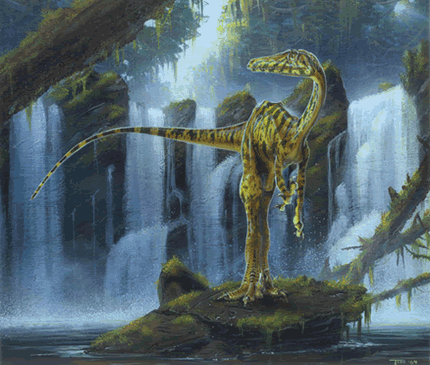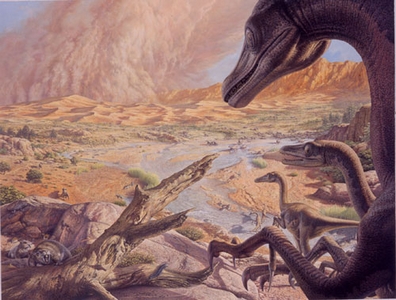Troodon formosos - Cretaceous Dinosaurs
Homepage > Cretaceous Dinosaurs - Troodon formosos
(TRO-uh-don) - "wounding tooth"
Describer Leidy, 1856
Also Known As Polydontosaurus, Gilmore, 1932. Stenonychosaurus, Sternberg,
1932. Pectinodon, Carpenter, 1982.
Type of Species --formosus
Order Saurischia
SubOrder Theropoda
InfraOrder Tetanurae
Micro-Order Maniraptora
Family Troodontidae
Size 6.5 feet (2 meters) in length
Period Late Cretaceous, 75 million years ago
Fossilsite "El Gallo" Formation, California Norte, Mexico; Horseshoe
Canyon Formation, Judith River Group, Alberta, Canada; Judith River Formation,
Hell Creek Formation, Montana, Lance Formation, Wyoming, US
Diet Bipedal Carnivore

Troodon was a bipedal carnivore that lived during the Late Cretaceous, about 75 million years ago. It was a relatively small dinosaur with a slender built. It measured approximately 6.5 feet (2 meters) in length, 3 feet (meters) tall, and weighted about 90 lbs (40 kilograms). The dinosaur’s long, slender hind limbs ended in elongated feet with three-weight bearing toes, the second toe armed with a deep, sickle-shaped claw similar to the one found in Deinonychus. These claws were rotated upwards while the animal ran. Its light built and powerful long hind limbs gave Troodon the ability to sprint at fast speeds. Its tail was shortened and distally stiffened.
 Troodon also had a large number of relatively small-serrated teeth. The
teeth varied in size and possessed as many as 35 teeth on each side of
the lower jaw. No other theropod is known to have had so many teeth. These
teeth also varied in shape depending on their location in the jaw. Its
forelimbs were long with grasping hands, and large eyes, about 2 inches
across, which are suggestive of good vision, possibly a nocturnal hunter.
Troodon may possibly possess the best binocular vision over other dinosaurs,
since its eyes were pointed slightly forward. Given the fact that the
animal lived in the northern areas of the globe where winter daylight
hours are shorter, keen eyesight was beneficial for survival.
Troodon also had a large number of relatively small-serrated teeth. The
teeth varied in size and possessed as many as 35 teeth on each side of
the lower jaw. No other theropod is known to have had so many teeth. These
teeth also varied in shape depending on their location in the jaw. Its
forelimbs were long with grasping hands, and large eyes, about 2 inches
across, which are suggestive of good vision, possibly a nocturnal hunter.
Troodon may possibly possess the best binocular vision over other dinosaurs,
since its eyes were pointed slightly forward. Given the fact that the
animal lived in the northern areas of the globe where winter daylight
hours are shorter, keen eyesight was beneficial for survival.
Scientists suspect that a combination of its anatomical weaponry made this theropod a very effective hunter of small mammals, which were almost all nocturnal during the Cretaceous. It may also have been an egg eater, since teeth remains have been discovered among shattered dinosaur eggs, suggesting these were part of its diet. Troodon is regarded as the most intelligent dinosaur yet discovered based on the size of its brain. Troodontids may have had the largest brains, relative to body size of any non-avian theropods.
Troodon is known from "El Gallo" Formation, Baja California
Norte, in Mexico; The Horseshoe Canyon Formation, Judith River Group,
in Alberta, Canada; The Judith River Formation, Hell Creek Formation,
in Montana, Lance Formation, in Wyoming, US. There is speculation that
Troodon favored cooler climates, as it seems to have been particularly
abundant in northern areas of the globe.
Discovery
The first fossil of Troodon was a single tooth discovered in 1954 by Ferdinand
V. Hayden in the Judith River Formation in Alberta, Canada. Based on this
tooth Joseph Leidy named and described the animal in 1856. However, Leidy
originally spelled Troödon (with a dieresis) in 1856, which was officially
amended to its current status by Sauvage in 1876. Leidy originally classified
the tooth as a "lacertian" (lizard), and later re-assigned as
a megalosaurid dinosaur by Nopsca in 1901. The similarity of troodontids
teeth to those of herbivorous dinosaurs continues to lead many paleontologists
to believe that these animals were omnivores. Troodon's tooth was not
matched with bones until the 1980’s.

Troodon specimen caused problems with classification, as the entire genus is based on a single tooth from the Judith River Formation. Since its discovery, post-cranial material from a related animal was given the name Stenonychosaurus. More complete remains convinced most paleontologists that Stenonychosaurus was in fact the same animal as the original tooth. Consequently, Stenonychosaurus was replaced by its senior synonym, Troodon.